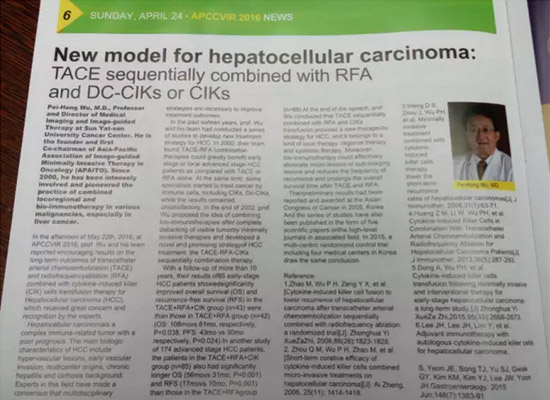古炽明 副主任医师
擅长:泌尿系肿瘤、泌尿系结石、前列腺疾病的微创腔镜诊治....[详情]
本文转载于:环球抗癌之家 微信公众号

封面图片:登上APCCVIR 2016大会快讯
2016年4月22日,在苏州召开的第十二届亚洲心血管介入放射学大会(APCCVIR 2016)上,中山大学肿瘤防治中心吴沛宏教授及其团队公布了中山大学肿瘤防治中心肝癌微创介入联合细胞因子诱导杀伤细胞(DC-CIK)治疗10年随访结果,引起了在场专家热议和认可,并登上了大会快讯头条。这项成果也昭示着我国肝癌的微创介入治疗及综合治疗的水平走在世界前列(图1)。

图1 吴沛宏教授在大会现场接过讲课证书
英文原文如下:
New model for hepatocellularcarcinoma: TACEsequentially combined with RFA and DC-CIKs or CIKs
Pei-Hong Wu, M.D。, Professor and Director of Medical Imaging and Image-guided Therapy at Sun Yat-sen University CancerCenter。 He isthe founder and first Co-chairman of Asia-Pacific Association of Image-guided Minimally Invasive Therapy in Oncology (APAITO)。 Since 2000, he has been intensely involved and pioneered the practice of combined locoregional and bio-immunotherapy in various malignancies, especially in liver cancer。
In the afternoon of May 22th, 2016, at APCCVIR 2016, prof.Wu and his team reported encouraging resultson the long-term outcomes of transcatheterarterial chemoembolization (TACE) and radiofrequencyablation(RFA)combined with cytokine-induced killer (CIK) cells transfusion therapy forHepatocellularcarcinoma (HCC), which received great concern and recognition bythe experts。
Hepatocellular carcinomais a complex immune-relatedtumorwith apoor prognosis。 The main biologic characteristics of HCCincludehypervascular lesions, early vascular invasion, multicenter origins,chronichepatitis and cirrhosis background。 Experts in this field have made a consensus that multidisciplinary strategies are necessary to improve treatment outcomes。
In the past sixteen years, prof。 Wu and his team had conducted a series of studies to develop new treatment strategy for HCC。 In2000, their team found TACE-RFA combinationtherapies could greatly benefit early stage or local advanced stage HCCpatients as compared with TACE or RFAalone。 At the same time, some specialists started to treat cancer by immunecells, including CIKs, Dc-CIKs, while theresults remained unsatisfactory。 Inthe end of 2002, prof。 Wu proposed the ideaof combining bio-immunotherapies after complete debarking of visible tumor byminimally invasive therapies and developed a novel and promising strategy ofHCC treatment: the TACE-RFA-CIKs sequentially combination therapy。
With a follow-up of more than 10 years, their results of 85 early-stage HCC patients showed significantly improved overall survival (OS)and recurrence-free survival (RFS) in theTACE+RFA+CIK group (n=43) were thanthose in TACE+RFA group (n=42) (OS: 108 movs 61 mo, respectively, P=0.038;PFS:43mo vs 30mo respectively, P=0.024)。 In another study of 174 advanced stage HCC patients, the patients in the TACE+RFA+CIK group (n=85) also had significantly longer OS (56 mo vs 31 mo, P=0.001)and RFS (17 mo vs 10mo, P=0.001)than those in the TACE+RFAgroup (n=89)。 At the end of thespeech,prof。 Wu concluded that TACE sequentially combined with RFA and CIKs transfusion provides a new therapeutic strategy for HCC, and it belongs toakind of local therapy, regional therapy and systemic therapy。 Moreover,bio-immunotherapycould effectively eliminate micro-lesions or sub-imaging lesions and reduces the frequency of recurrence and prolongs the overall survival time after TACEand RFA。
Their preliminary results had been reported and awardedat the AsianCongress of Cancer in 2005, Korea。 And the series of studies havealso beenpublished in the form of five scientific papers on the high-level journals in associated field。 In 2015, a multi-centric randomized control trial including four medical centers in Korea draw the same conclusion。
Reference:
1.Zhao M, WuP H, Zeng Y X, et al。 [Cytokine-inducedkiller cell fusion to lower recurrenceof hepatocellular carcinoma aftertranscatheter arterial chemoembolizationsequentially combined withradiofrequency ablation: a randomized trial][J].Zhonghua Yi Xue Za Zhi,2006,86(26):1823-1828。
2。 Zhou Q M, Wu P H, Zhao M, et al。 [Short-termcurativeefficacy of cytokine-induced killer cells combined micro-invasivetreatments onhepatocellular carcinoma][J]。 Ai Zheng, 2006,25(11):1414-1418。
3.Weng D S, Zhou J, Wu PH, et al。 Minimally invasivetreatmentcombined with cytokine-induced killer cells therapy lower theshort-term recurrence rates ofhepatocellular carcinomas[J]。 J Immunother,2008,31(1):63-71。
4.Huang Z M, Li W, Wu PH, et al。 Cytokine-induced KillerCellsin Combination With Transcatheter Arterial Chemoembolization andRadiofrequencyAblation for Hepatocellular Carcinoma Patients[J]。 J Immunother,2013,36(5):287-293。
5.Dong A, Wu PH, et al。 Cytokine-induced killercellstransfusion following minimally invasive and interventional therapyforearly-stage hepatocellular carcinoma:along-term study。[J] Zhonghua Yi Xue Za Zhi,2015,95(33):2668-2673。
6.Lee JH, Lee JH, Lim Y, et al。 Adjuvantimmunotherapywith autologous cytokine-induced killer cells for hepatocellularcarcinoma。
S, Yeon JE, Song TJ, Yu SJ, Gwak GY, Kim KM, Kim YJ, LeeJW,Yoon JH。 Gastroenterology。 2015Jun;148(7):1383-91
家庭医生在线专稿,转载请注明家庭医生在线;媒体合作请联系:020-37617238
(责任编辑:郑梦雪 )
文章关键词:
鼻咽癌是东南亚及华南非常常见的恶性肿瘤。对于早期和局部晚期的鼻咽癌患者,标准的治疗方案是放化疗,但绝大多数患者最终出现远处转移。此外,大……详细>>
2016年6月3日——7日,第52届美国临床肿瘤学会年会(ASCO)在美国芝加哥盛大举行。详细>>
(中山大学肿瘤防治中心报道)第十三届世界食管疾病大会于2015年8月31日-9月3日在欧洲摩纳哥(Monaco) Grimaldi国际会……详细>>
癌症是一类复杂的常见病、多发病。全球每年因癌症死亡的人数约为820万,其中中国占27%。根据世界卫生组织最新发布的《全球癌症报告2014……详细>>
2016年11月3日,中山大学肿瘤防治中心中新广州知识城院区项目在中新广州知识城南举行开工仪式。详细>>